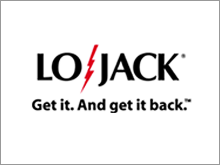|
LoJack stock is a steal The car-security company has a strong brand name, effective technology, plenty of cash, and solid earnings growth, but shares are off 30% from their one-year high.
(FORTUNE) -- In the security business, stealth can be a plus. So maybe it's a good sign that LoJack, the global vehicle tracking-and-recovery giant, has been flying under investors' radar lately. The company has grown earnings for four straight years, has plenty of cash, and just beat everyone's expectations in the second quarter (which ended in early August). Yet its stock (LOJN (Charts)) is trading at just under $20, down from a peak near $30 a year ago. We think that makes it a serious bargain right now.
LoJack, a $190 million company, is the big brand name in car-security systems. Between its early detection system (which alerts you if your car is started without a special key) and its recovery network (which enables police to track the location of a stolen car), LoJack is installed on just over 5 million vehicles in 26 U.S. states and 27 countries. So why is Wall Street down on this category-dominating company? First of all, in a world where investors only seem to get excited about technologies that start with "e" or "i," LoJack's basic device hasn't changed much since 1986. (Then again, it doesn't need to, since it still has a 90% success rate of finding stolen vehicles). Second, investors naturally assume that LoJack's sales track overall auto sales, which have been stagnant in the U.S. since 2000 and especially weak in the past year. Third, and perhaps most important, LoJack's gross profit margin took a hit in the first quarter of 2006, falling to 51% from historical averages closer to 60%. That signaled to some investors that LoJack's recent stellar performance - with average annual net income growth of 55% since 2003, on 13% annual revenue growth - was coming to an end. But results for the second quarter of this year (which were just announced) proved that wasn't the case. Gross margins jumped back up to 57%. Earnings and revenue beat expectations. "The reporting this quarter signaled that things were just fine," says Andrew Spinola, an analyst at Needham. "It confirmed their strong brand, and that they're still a cash-flow machine." Okay, so it's cheap right now. But how does LoJack, with what's basically a 20-year-old technology and a saturated brand identity, keep growing? Does it still have enough juice to convince investors that it's a stock worth buying? Yes, for many reasons. Since LoJack's technology only works on a local scale, there are always new towns (and even new states) for it to grow into. And trends in auto sales - despite being flat overall - very much favor LoJack. LoJack is a high-margin add-on to any new car that dealers, who are being squeezed by rock-bottom pricing from manufacturers, absolutely love to sell. LoJack has also kept tweaking its business model. The new big thing is bulk installation - convincing dealers to install it on all their cars before they're sold. This not only forces car shoppers to spring for it, but has the added benefit of protecting cars on the lot from theft. Other innovations include LoJack for Motorcycles, a new business in 2005 that promises to double in 2006; LoJack for Construction Equipment; and LoJack for Laptops, which licenses the LoJack brand name to a third party that uses its own technology. "These segments leverage a lot of what we already have internally," says CEO Joseph Abely, who's been with LoJack since 1988, "so they're very profitable for us." LoJack is also sold abroad, and the international market represents about 30% of their revenue. Until recently, all LoJack units sold outside the U.S. were through licensed dealers, only some with the LoJack brand. This segment is very profitable, but growth is limited to how fast these small licensees can grow (often not very fast). But this year, LoJack launched its first majority-owned subsidiary outside the U.S., in Italy, where it is promoting the LoJack brand and establishing its own partnerships with police. A recent report at J.P. Morgan said that Italy was "tracking to plan" and estimated $1.5 million in revenues the first year, with minimal downside risk. Overall, however, the international market also presents one of LoJack's biggest risks. In some countries, like Brazil, Argentina, and Canada, insurance companies mandate LoJack systems. If those rules change, sales could plummet. It will also be a challenge for LoJack to help its licensees grow, and that might require new investment, like in Italy, to launch under its own brand name. The other risk for investors is whether and how LoJack will execute a long-discussed plan to start adding LoJack trackers to hazardous materials and international cargo. Obviously, post-9/11, these could both be big businesses. But so far, to the disappointment of some analysts and shareholders, the company hasn't announced concrete plans yet. That said, there's no reason to believe LoJack won't execute, as it has with the motorcycle business and Italy. "We are looking both at developing solutions in house, and at what people have out there," says CEO Abely. "It takes time to do. We are making progress, but I hesitate to put out a timeframe." The stock might be trading down right now, but all signs point to continued double-digit revenue and profit growth. Next quarter's report should send investors the signal that LoJack is still a great company, especially with handy growth figures from new business lines to show at conferences. That should make everyone feel more secure. ------------------------------------- |
Sponsors
|

